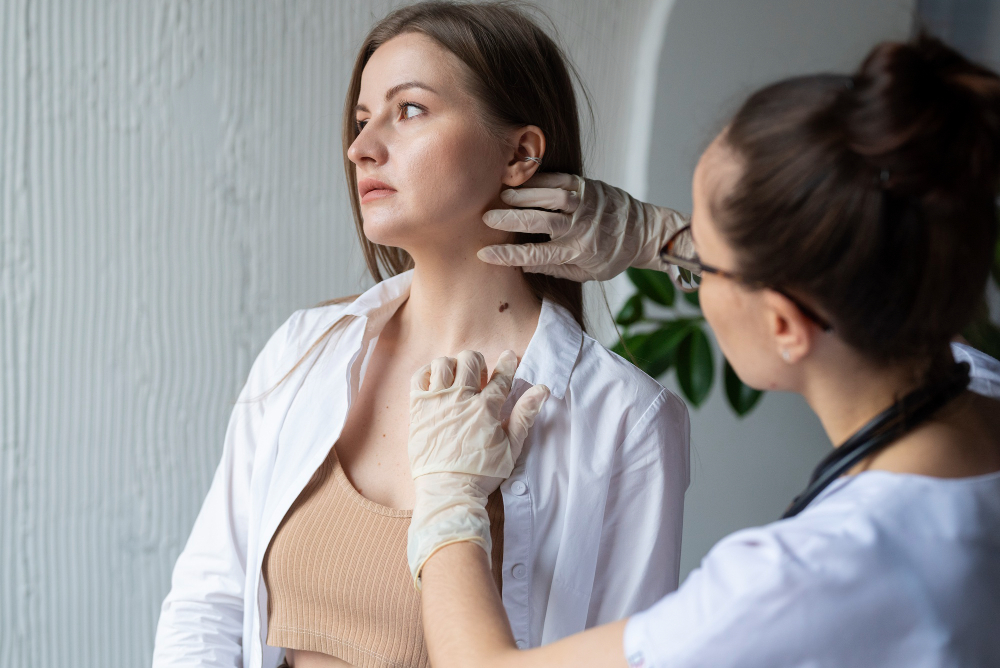
Skin Tag Removal: Proven Methods to Get Clear, Smooth Skin
Skin tags are small, soft growths that can appear on different parts of the body. They are usually harmless, but many people find them annoying or unattractive. If you have skin tags, you might be wondering how to remove them safely and effectively. Fortunately, there are many ways to get rid of them, from natural remedies to medical treatments. The good news is that you don’t have to live with skin tags forever—there are proven ways to remove them and achieve smooth, clear skin.
What Are Skin Tags and Why Do They Appear?
Skin tags are tiny, flesh-colored growths that often form in areas where the skin rubs against itself, such as the neck, armpits, eyelids, groin, and under the breasts. They are made up of collagen fibers and blood vessels covered by a thin layer of skin. While they are not painful, they can be irritating, especially if they get caught on clothing or jewelry.
The exact cause of skin tags is not always clear, but friction plays a major role in their development. They are more common in people who are overweight, pregnant, or have diabetes. Genetics can also be a factor, meaning if your family members have skin tags, you might develop them too. Although they are harmless, many people look for effective skin tag removal methods because they don’t like the way these growths look on their skin.
Can Skin Tags Fall Off on Their Own?
In some cases, skin tags might shrink or fall off naturally, but this is rare. Most of the time, they stay on the skin unless they are removed. Because they are not dangerous, doctors usually don’t recommend treatment unless the skin tag is causing discomfort. However, if your skin tag is in a noticeable place or is getting irritated by friction, you might want to remove it.
There are many ways to remove skin tags, from at-home remedies to medical treatments. Some people try to cut them off themselves, but this is not recommended because it can lead to infection or bleeding. Instead, there are safer and more effective options to consider.
Natural Remedies for Skin Tag Removal
Many people prefer natural methods to remove skin tags because they are gentle and less expensive than medical procedures. Some of the most popular natural remedies include apple cider vinegar, tea tree oil, and garlic.
Apple cider vinegar is believed to break down the skin tag tissue, causing it to dry out and fall off. Applying a small amount of vinegar to a cotton ball and securing it to the skin tag for a few hours each day may help. Similarly, tea tree oil is known for its antibacterial and drying properties. When applied regularly, it may cause the skin tag to shrink and disappear. Garlic is another natural remedy that some people use to remove skin tags. By crushing fresh garlic and applying it to the skin tag, you might be able to speed up the removal process.
While natural remedies work for some, they take time and results can vary. If you’re looking for a faster way to remove skin tags, there are other proven methods available.
Over-the-Counter Skin Tag Removal Products
For those who want a convenient and effective way to get rid of skin tags, over-the-counter treatments can be a good option. These products are designed to dry out the skin tag, causing it to fall off after a few days or weeks.
One common type of treatment is a freezing solution, similar to what doctors use. These products work by applying liquid nitrogen to the skin tag, which destroys the tissue. Another option is a skin tag removal cream that contains ingredients to break down the tag over time. Some people also use skin tag removal patches that cover the tag and slowly weaken it until it falls off.
These treatments can be effective, but it’s important to follow the instructions carefully. Using them incorrectly can cause irritation or damage to the surrounding skin. If you have sensitive skin or a large skin tag, you might want to consult a doctor before trying an over-the-counter product.
Medical Procedures for Skin Tag Removal
If you want immediate results, medical treatments are the fastest and most effective way to remove skin tags. Doctors have several ways to get rid of skin tags safely, including cryotherapy, cauterization, and surgical removal.
Cryotherapy is a procedure where a doctor applies liquid nitrogen to the skin tag, freezing it off. The tag will usually fall off within a few days. Cauterization is another option, where the skin tag is burned off using an electric current. This method prevents bleeding and reduces the chance of regrowth. For larger skin tags, a doctor may choose to cut them off using sterile scissors or a scalpel. This method provides immediate results, but it may require a small bandage afterward.
Medical procedures are highly effective and safe, especially when done by a professional. If you have multiple skin tags or if they are in a sensitive area like the eyelids, it’s best to seek professional help for removal.
Preventing Skin Tags in the Future
Once you’ve successfully removed your skin tags, you might be wondering how to prevent new ones from forming. While there is no guaranteed way to stop them completely, there are a few things you can do to reduce your chances of developing more.
Keeping your skin clean and dry can help, especially in areas where friction is common. Wearing loose-fitting clothing can also minimize irritation. If you are prone to skin tags, maintaining a healthy weight and managing conditions like diabetes may reduce your risk. Some people also find that regularly moisturizing their skin with natural oils helps prevent skin irritation that can lead to skin tags.
If you notice new skin tags forming, don’t panic. They are a common part of life, and there are always ways to remove them safely. Whether you prefer natural remedies, over-the-counter treatments, or medical procedures, you have plenty of options to achieve smooth, clear skin.

How to take Zopiclone Sleeping Pill (where can buy Zopiclone UK)
Zopiclone is an FDA-approved medicine for people who are unable to manage their insomnia and have a sleep disorder. This active ingredient has gained huge popularity in the Zopiclone UK because of its effectiveness as compared to other medicines in the category. Moreover, one more factor that has added to its wide acceptance is convenience and rapid onset.
The medicine has Zopiclone 7.5mg of active ingredient in each white cylindrical tablet sold under the Zopicon name. The manufacturing of this medicine is done by Intas Pharmaceutical. Today many people are using it as a quick solution because of the rising day-to-day stress.
Advantages of Using Zopiclone for Sleep Issues
● The biggest advantage of using the medicine is that it acts very quickly. Within 30 minutes a person is in sound sleep.
● Being a sedative, the medicine causes very little grogginess keeping you refreshed the next day.
● The medicine will improve the experience of sleep by elevating its quality.
● The medicine is used to resolve short-term sleep disorders without causing any long-term disturbances.
Zopiclone Working
The working of Zopiclone Sleeping Pills medicine is pretty simple. When you consume the medicine it takes around 20 minutes to dissolve in the body. When the salt dissolves in the body, it reaches the neuro-receptors in the brain- GABA (Gamma-aminobutyric acid). It is a chemical messenger that helps a person sleep because it blocks some specific signals in the central nervous system inducing a calming effect.
Due to stress and day-to-day tensions, these GABA receptors are unable to work properly leading to insomnia. The Zopiclone salt will attach to the GABA receptors and enhance its activity of slowing down the brain. The salt has a half-life of 5-6 hours due to which a person can enjoy a deep and sound full night’s sleep. To achieve the best results, one should make sure that they keep the use of the medicine short-term.
How to Take Zopiclone?
● Consume Zopiclone half an hour before your time to sleep. The reason why it is suggested is because the medicine takes 15-20 minutes to act in your body.
● When you are using the medicine, make sure you have an empty stomach. It means you need to have at least 2-3 hours of gap between dinner and sleep time.
● The best practice to consume the medicine is to swallow it. Never crush or chew it otherwise it might not work properly.
● Don’t consume alcohol and also try to have a light dinner when using the medicine.
Safe Dosage Guidelines for Zopiclone
The safe dosage of Zopiclone is prescribed by the physician based on the age and current problems that the body is facing. In general, if you are a normal person then a 7.5mg dose before sleep is sufficient for you. But if you are old or have any issues related to the liver, lungs, or kidneys it is prescribed with a lower dosage i.e., 3.75mg.
All you as a patient need to do to ensure your safety is share all the information regarding your medical history and the list of medications you are consuming. Moreover, while you are taking your medicine, take care of the side effects and if the severity increases, consult your physician.
Can Zopiclone Lead to Dependency?
Zopiclone medicine is known for its no to less dependency because it is suggested for the short-term. But if you consume the medicine for an extended duration outside of your prescribed period, then it might cause dependency. It happens because your body will become tolerant to the sedative nature of the salt.
Due to this, a person starts using a higher dose to achieve the same effects as they were getting initially leading to dependency. That is why it is suggested that you should consume the medicine only for the short term and strictly follow the prescription.
Potential Side Effects of Zopiclone
● Due to the sedative effects of the medicine, a person might notice drowsiness and nausea sometimes.
● Dizziness might also happen due to which a person is unable to make balance.
● In severe cases, vomiting might also happen because of gastric issues.
● Headache and memory lapse can also happen because of the medicine consumption.
● Dry mouth and bitter taste might also happen in the body.
● The medicine can also cause memory problems.
● Zopiclone can also cause severe allergies in severe cases.
● Difficulty in breathing might also happen due to this medicine.
● The medicine consumer might also cause unusual behavior.
Important Precautions When Using Zopiclone
● When you visit your physician, make sure to share your medical history and list of current medications.
● Women who are pregnant or breastfeeding their newborn should never take the help of Zopiclone. It can be harmful to the child.
● The medicine can cause dizziness and impaired judgment. That is why one should not drive or operate heavy machinery.
● The medicine consumer must make sure that they don’t intoxicate themselves with alcohol and drugs. It can lead to an increase in the sedative effects and extreme drowsiness.
● When you stop the medicine consumption, check for withdrawal symptoms. If it appears, contact your physician.
● If you miss the medicine dose, skip it. Continue the dose of the medicine from the next at the same time.
Customer Experiences with Zopiclone
| Emma R. I’ve struggled with insomnia for years, and Zopiclone was a game-changer for me. I’ve been able to fall asleep faster and stay asleep through the night. I didn’t even feel groggy the next morning, that commonly happens with other sedatives. It’s been a lifesaver, especially during stressful work periods. | Michael T. I was hesitant about taking any medication for sleep, but after weeks of sleepless nights, I gave Zopiclone a try. It worked wonders! I felt rested the next day, and I didn’t experience any serious side effects. The only issue I faced was slight dizziness the first couple of times I used it, but that passed. Now whenever I need to use the medicine, no side effects appear. |
| Clara J. I’ve been using Zopiclone for 2 weeks now, and it has really helped me with my anxiety-induced sleep issues. I feel like I can get a full night’s rest again. I make sure to follow the doctor’s advice to avoid dependency and after a week, I will be stopping the dose. | Paul B. Zopiclone has been a great help in getting me to sleep, especially during times when I struggle with sleepless nights. It worked quickly and allowed me to rest well. Over time, I’ve been working closely with my doctor to find a more sustainable long-term solution, but Zopiclone has definitely been an effective temporary fix that gave me much-needed relief. |

Medical Weight Loss Program Singapore for Men
Why Men Require Medical Assistance for Losing Weight Men store fat differently compared to women.
The majority of men accumulate fat around the midriff area. Such fat is more harmful to health. A weight loss clinic in Singapore is beneficial. It addresses the particular issues men encounter while losing weight.
Excess weight leads to severe health issues in men:
- Elevated risk of heart disease
- Heightened risk of diabetes
- More likely to have sleep apnea
- Worsening joint pain
How Medical Weight Loss Works
Your holiday begins with a thorough medical check-up. Your doctor will:
- Test your blood
- Record your vital signs
- Measure your body composition
- Check your medical history
On the basis of these results, doctors create a plan just for you. It is much better than trend diets. It works to meet your individual health needs.
Singapore clinics provide ongoing doctor supervision. They track your progress with regular check-ups. Your plan is adjusted based on how your body responds.
Key Components of Medical Weight Loss
Hormone Balance
Testosterone influences the way men lose fat. Low levels make losing weight more difficult. Low levels also decrease muscle and energy.
Physicians can diagnose and reinstate hormonal issues. Hormonal balance assists:
- Burn belly fat quicker
- Gain more muscle
- Boost energy
- Enhance exercise outcomes
Weight Loss Medications
Doctors can write FDA-approved medications whenever and wherever needed. They may:
- Relieve hunger
- Suppress appetites
- Make you feel full for longer
- Alter the way your body processes fat
Medical monitoring makes these drugs safe. Physicians oversee side effects. Dosage is regulated as appropriate.
Dietary Plans
A Singapore weight loss program includes customized meal plans. These are derived from your:
- Metabolism
- Food flavors
- Working hours
- Health conditions
Plans fit within Singapore’s food culture. You’ll discover how to eat at hawker centers. You’ll get advice for eating out with your friends.
Metabolism Testing
Special equipment measures how many calories you expend when you are at rest. This tells you exactly how much you should be eating. No more guessing at portion sizes.
Testing reveals underlying issues that are making it hard to lose weight. Some men metabolize carbs differently. Others might require more protein. Your plan takes these needs into account.
Mind and Behavior Support
Weight loss is not just about diet and exercise. It is also about habit-breaking. A weight loss program Singapore provides:
- Stress management strategies
- Strategies for managing emotional eating
- Tools to stay motivated
- Strategies for challenging situations
You’ll learn to identify what leads to unhealthy eating. Then you’ll rehearse healthier reactions. These cognitive skills have long-term effects.
Advantages of Weight Loss Programs Singapore for Men
A weight loss program Singapore is faster than attempting to do so independently. Men generally lose 5-10% of weight in three months. The health benefits start right away:
- Improved sleep
- Additional energy
- Reduced blood pressure
- Better cholesterol
- Balanced blood sugar
- Less joint pains
- Greater confidence
Body Composition Analysis
Weight programs at the doctor’s office are not only tracking your weight. They monitor percentage of fat and muscle. It provides a healthier overview of your condition.
Body composition analysis uses the latest technology. It reveals precisely where you are losing fat. It allows doctors to make alterations in your treatment plan for improved outcomes.
Slimming down and still having muscle mass is the ultimate aim. Periodic scans indicate whether you are achieving this good change. The weight alone will not tell the whole story.
Men observe significant changes in body composition. Waistlines narrow as harmful visceral fat dissolves. Muscle definition is more apparent even when weight loss appears to be more gradual.
Selecting a Program in Singapore
Search for the following in a weight loss clinic Singapore:
- Physicians specializing in weight management
- Complete medical staff in a single facility
- Evident success stories from male patients
- Long-term follow-up following weight loss
- Reasonable expectations, not miracle promises
Ask them how they intend to sustain long-term success. The most effective programs are designed to keep weight off, not lose it.
Post-Program Maintenance Support
As crucial as losing weight is keeping the weight off. Singapore includes maintenance programs in their medical plans.
These plans help you transition to self-managed health. They include:
- Progressively increasing calorie goals
- Less frequent but regular monitoring
- Coping mechanisms for weight changes
- Assistance during high-risk times such as holidays
Continuing care avoids the frustrating roller coaster of weight loss and regain. Maintenance programs are available for as long as two years following goal achievement at some clinics.
Studies demonstrate that patients who are in regular contact with health professionals lose more weight. Even monthly monitoring considerably enhances long-term outcomes. This frequent contact allows for accountability and early intervention.
Staying Successful
Health programs teach lifetime health skills. You will learn to:
- Eat right for your body
- Exercise regularly
- Manage stress without food
- Maintain new habits
Follow-up care keeps you on track after you have achieved your goal. Regular visits prevent you from regaining weight. Little problems are corrected before they become bigger.
Spend on a weight loss program singapore invests in the long term. You’ll avoid costly health conditions. For a man in Singapore, it’s the smartest means to better health.

The Ultimate Guide To Finding Your Perfect Dentist: Tips and Tricks
Finding a dentist who meets your needs and exceeds your expectations is crucial to maintaining good oral health. The rapport you establish with your dentist, the quality of care you receive, and the overall experience can have a lasting impact on your dental wellness. Whether you’re looking for a routine check-up or a specialized procedure, the right dental professional can make all the difference. In this article, we will delve into how you can find a dentist who’s the right fit for you. Keep reading for insightful advice on considerations ranging from credentials to comfort, and from convenience to patient feedback.
Utilizing Online Reviews and Testimonials in Your Decision Process
Online reviews are a useful tool for evaluating dental services, offering insight into a dentist’s approach, office environment, and treatment success. Look for patterns in feedback and focus on specific, constructive reviews rather than overly emotional or vague ones.
While online reviews help, personal recommendations can be even more reliable. If friends or family highly recommend a dentist, take note as these firsthand experiences often provide the best insight. If you’re searching for the best dentist in Miami Florida, consider both online feedback and direct referrals to make the right choice.
Understanding the Importance of Choosing the Right Dentist
Choosing the right dentist is more than just cleaning teeth; it involves a dental professional who is invested in your long-term health and has the knowledge to identify potential oral health issues before they escalate into more severe problems. Poor oral health can lead to discomfort, pain, and systemic health complications.
A dentist who you trust and feel comfortable with is essential for your health journey. The quality of the patient-dental professional relationship is also crucial. A dentist who takes the time to address your questions and concerns makes you feel valued and involved in your dental care. A positive dental experience is essential for achieving and maintaining optimal oral health.
Evaluating Dentist Credentials and Experience
Dentist qualifications are crucial in selecting a dentist. Ensure they are licensed and practice in your state. Experience is also important, as a dentist with a long history of practice can handle various dental issues and offer both classic and modern treatment options. Specialized services, such as orthodontics or cosmetic dentistry, are essential for better outcomes.
Choose a dentist with expertise in these areas. Consider their professional development pursuits, as a dedicated professional with memberships in professional organizations and ongoing education can demonstrate their dedication to their craft. Choosing a dentist based on their qualifications, experience, and commitment to continuous learning is essential for a successful dental experience.
Considering Location and Office Hours for Convenience
Choosing a dentist’s office is crucial for convenience and regular visits. It’s important to find one that is easily accessible, especially for procedures requiring multiple sittings or emergency situations. Office hours should align with your schedule, with some offices offering evening or weekend appointments.
A user-friendly online booking system or efficient phone service can save time and frustration. Good communication with staff is also important. Proximity to other healthcare services, such as larger centers, can provide seamless coordination with other medical professionals, especially for patients with interrelated dental and medical issues.
Assessing Communication and Patient Comfort
Effective communication between patients and dentists is crucial for a successful dental experience. Dentists should provide clear explanations about oral health status, treatment options, and preventive care, and listen to patients’ concerns to make informed decisions. Patient comfort is also important, as it goes beyond pleasantries and a comfortable waiting area. A dentist who prioritizes patient comfort may offer sedation options for those with dental anxiety.
Support staff interactions, such as friendly and competent administrative staff, can also enhance the overall experience. Digital communication, such as electronic health records and appointment reminders, can streamline the experience and ensure patients are well-informed about their dental health journey. These practices are often forward-thinking in other areas of patient care.
Overall, selecting the right dentist is a process that deserves careful consideration. Conducting thorough research, examining a dentist’s credentials and experience, and considering your own comfort and convenience needs are all essential steps in finding your perfect dental match. By seeking out reviews—both online and from personal sources—you can gain valuable insights that help solidify your choice. Remember, a great dentist is key to not just a great smile, but also to your long-term health and well-being.

AI in healthcare in India: Top hospitals using AI
In a country where healthcare accessibility and quality often vary, how can Artificial Intelligence (AI) produce a real impact? AI in healthcare in India now changes how hospitals approach patient care, diagnostics, and treatment plans. As India faces challenges such as a shortage of medical professionals and a strained healthcare system, AI provides a promising answer to narrow these gaps. Hospitals nationwide already adopted AI to improve diagnostic accuracy, streamline processes, and deliver more personalized care. This article examines how top hospitals in India integrate AI into their work and its effect on the healthcare sector and patient outcomes.
How is AI used in healthcare in India
While AI adoption is still evolving, its applications already span across diagnostics, hospital operations, and patient care. From decision-support systems to automated patient engagement, AI-driven solutions have the potential to make medical services faster, more accurate, and more accessible. These applications are already helping hospitals bridge gaps in healthcare availability.
Disease detection and diagnostics
AI in healthcare is revolutionizing disease detection, particularly in areas such as cancer, heart disease, and diabetes. Machine learning (ML) algorithms are being used to analyze medical images like X-rays, CT scans, and MRIs, which help doctors detect conditions at earlier, more treatable stages, and contribute to better electronic health record integration for patient data management.
For example, Apollo Hospitals utilizes AI to improve stroke diagnosis, reducing the time it takes to diagnose a stroke from 60 minutes to just two minutes. Similarly, NIRAMAI Health Analytix has developed AI-based breast cancer screening technology that uses thermal imaging to detect tumors five times smaller than those identified through clinical exams.
Process Optimization
Artificial intelligence in healthcare can help providers improve how they manage tasks and provide care. This can lead to better performance in hospitals. In many Indian hospitals, AI systems manage bed occupancy, predict patient flow, and optimize insurance claims processing. This helps hospitals better allocate resources, reduce wait times, and lower costs. For instance, AI applications predict “patient churn” (the turnover of hospital beds), allowing better bed management in hospitals across India.
Personalized Treatment
AI plays a key role in personalized medicine, as it changes treatments according to individual patients based on their unique data. Hospitals in India are collaborating with tech companies to use AI to create custom treatment plans. For example, IBM Watson for Oncology is being used by Manipal Hospitals to help doctors discover personalized cancer care options. This platform uses AI to analyze a lot of clinical data and recommends the best treatment plans. This helps improve patient outcomes and reduces the trial-and-error process found in traditional care.
AI in medical research and drug development
Indian healthcare institutions and biotech companies are using AI to accelerate drug discovery and improve clinical research. Deep learning algorithms analyze complex biological data to identify potential treatments faster than traditional methods. AI-assisted research speeds up drug development as it can identify promising compounds for testing. AI-driven molecular analysis helps create personalized medicine by customizing treatments based on individual genetic profiles.
The adoption of AI in healthcare in India continues to expand, with hospitals integrating AI to improve diagnosis, streamline hospital operations, and offer better patient care. As AI technology advances, its role in shaping India’s healthcare landscape will become even more prominent, driving better outcomes across hospitals nationwide, especially through the development of AI medical records summary systems that enhance patient data accessibility and management.
Top 7 hospitals in India that use AI
India’s top hospitals now integrate AI into their healthcare systems to improve diagnostic accuracy and streamline operations and patient care. With AI-powered tools, hospitals detect diseases earlier, personalize treatment plans, and optimize resource management. These advances are very important in a country where healthcare demand often outstrips available resources and access to specialized care remains a challenge in rural areas. The following hospitals stand out for their adoption of AI. They use technology to improve healthcare outcomes and deliver world-class medical services in their respective fields.
1. Apollo hospitals
Location: Nationwide, with major hospitals in Delhi, Hyderabad, Bangalore, Chennai, and Mumbai.
Apollo Hospitals is one of India’s largest and most recognized healthcare chains, with a reputation for providing high-quality medical services across a wide spectrum of specialties. Established in 1983, it operates over 70 hospitals across India. It’s known for its excellence in medical research and clinical outcomes, especially in areas like cardiology, neurology, and cancer care.
Apollo Hospitals has integrated AI into its stroke management system, which enables doctors to diagnose strokes more rapidly and accurately. The AI system processes brain scans to assess stroke severity in real-time, cutting diagnosis time from 60 minutes to just 2 minutes. The hospital also uses AI to improve predictive analytics in cardiology and provide personalized treatment plans based on patient data.
2. Fortis Healthcare
Location: Nationwide, with major hospitals in Delhi, Gurgaon, Mumbai, and Bangalore.
Fortis Healthcare operates 30 hospitals across India, focusing on specialties such as cardiology, nephrology, oncology, and orthopedics. With its roots in the establishment of the Fortis Escorts Heart Institute in 1996, Fortis is widely recognized for affordable, high-quality medical care. The hospital group has earned accolades for its world-class emergency services, critical care units, and transplant facilities.
Fortis Healthcare is well-regarded for its cardiology department, with advanced diagnostic and surgical procedures such as angioplasty, bypass surgery, and valve replacement. The hospital also offers specialized services in neurology, orthopedics, and fertility treatments, alongside trauma and emergency care. AI systems are being used to analyze medical imaging, such as CT scans and MRIs, to support oncologists in making more accurate and timely diagnoses. Fortis is also working on AI-driven personalized treatment plans to improve patient outcomes and minimize treatment costs.
3. Tata Memorial Hospital
Location: Mumbai, Maharashtra
Tata Memorial Hospital is a leading cancer center in India, that provides excellent cancer care, including chemotherapy, radiation therapy, and palliative care. Founded in 1941, Tata Memorial is dedicated to improving cancer treatment through research, education, and clinical services. It is recognized as one of the top oncology centers in India, offering both public and private treatment options.
The hospital is using AI for predictive analytics and optimization of the treatment strategies for cancer patients. AI models assist oncologists in analyzing medical data, helping them create more advanced and personalized treatment plans. In addition to AI, Tata Memorial offers treatments in cancer research, bone marrow transplants, and radiation oncology.
4. Manipal Hospitals
Location: Nationwide, with major hospitals in Bangalore, Delhi, Jaipur, and Goa.
Manipal Hospitals is one of the most respected healthcare providers in India, operating 29 hospitals across the country. Known for its expertise in cardiology, urology, neurology, and orthopedics, Manipal has earned a strong reputation for its world-class care. The hospital is also recognized for its excellence in minimally invasive surgeries and organ transplant programs.
Manipal Hospitals has partnered with IBM Watson for Oncology, using AI to provide personalized cancer treatment plans. The AI system helps oncologists analyze patient data, medical histories, and the latest research to make more informed decisions about cancer care. In addition to AI, Manipal offers treatments for kidney diseases, spinal disorders, and diabetes.
5. Narayana Health
Location: Nationwide, with major hospitals in Bangalore, Kolkata, and Jaipur.
Founded by Dr. Devi Shetty, Narayana Health has grown into one of India’s most affordable yet world-class healthcare providers. Narayana operates 21 hospitals and offers specialized treatments in cardiology, pediatrics, neurology, and nephrology. It’s famous for performing high-volume cardiac surgeries at lower costs, Narayana Health has earned a reputation for making advanced healthcare accessible to a wider population.
Narayana Health is collaborating with Google to develop AI-powered imaging tools for diagnosing lung diseases and cardiac conditions. The use of AI helps doctors detect heart conditions earlier, improving treatment outcomes. Beyond AI, Narayana Health has expertise in heart surgeries, kidney transplants, and pediatric care.
6. Medanta – The Medicity
Location: Gurgaon, Haryana
Medanta – The Medicity is one of India’s most renowned multispecialty hospitals with a wide range of services in cardiology, oncology, neurology, and orthopedics. With state-of-the-art infrastructure and world-class medical technology, Medanta has earned recognition for its expertise in organ transplants, including liver, heart, and kidney transplants.
Medanta is using AI-driven tools in radiology and pathology to enhance the accuracy of diagnoses, particularly for complex diseases. By integrating AI into clinical decision-making, the hospital is improving diagnostic timelines and enabling more precise treatments. In addition to AI, Medanta provides cutting-edge services in surgery, endocrinology, and emergency care.
7. Aravind Eye Hospital
Location: Madurai, Tamil Nadu
Aravind Eye Hospital is the largest eye care network in India, known for providing affordable, high-quality eye care services. The hospital specializes in cataract surgeries, glaucoma treatments, and retinal care. Aravind’s model is built around making quality eye care accessible to rural populations, with over 40 centers across India.
Aravind Eye Hospital collaborates with Google to implement AI for the early detection of diabetic retinopathy. The AI-powered system helps detect retinal diseases at an early stage, improving patient outcomes by facilitating early treatment. Along with AI, Aravind offers other eye care services like cataract surgeries, glaucoma treatments, and pediatric ophthalmology.
These hospitals are leaders in healthcare innovation and are also making strides in integrating AI to improve diagnostic accuracy, and treatment plans, and streamline hospital operations. Through these efforts, they continue to raise the standard of healthcare in India and provide better, more accessible care for patients across the country.
The future of AI in Indian healthcare
With the promising future of AI in healthcare India holds immense potential to transform the sector further and address longstanding challenges. With advancements in machine learning, deep learning, and natural language processing, AI is expected to play an even greater role in disease detection, personalized treatment, and healthcare management. As technology continues to evolve, AI will likely enable more sophisticated diagnostic tools, leading to earlier detection of conditions like cancer and heart disease.
Furthermore, AI-driven platforms will improve accessibility, particularly in rural areas, by providing virtual consultations, remote monitoring, and telemedicine services. AI can also help optimize healthcare resources, reduce inefficiencies and lower costs. With the government’s growing focus on digital health infrastructure, AI is set to become an integral part of the Indian healthcare ecosystem, boosting the quality of care and making healthcare more accessible and affordable for all.
Conclusion
The incorporation of AI in healthcare in India has a great effect on patient care, diagnosis, and hospital operations. As AI advances, its capacity to solve resource constraints and limited access in rural areas increases. When more hospitals adopt AI-driven tools, India’s healthcare system stands on the brink of a transformative shift that benefits both patients and medical professionals.
FAQ
While the adoption of AI in Indian hospitals can involve great initial investment, the long-term benefits like reduced diagnostic errors, optimized resource management, and better patient outcomes, can offset these costs. Moreover, AI-driven systems are becoming more cost-effective with increased development and wider implementation, which helps hospitals manage their expenses.
The Indian government has initiated policies like the National Digital Health Blueprint (NDHB) and the National Health Stack to establish a framework for AI in healthcare. These initiatives aim to create an advanced infrastructure for digital health, facilitating AI adoption while addressing challenges in data privacy and security. However, clear regulations on AI-driven medical decision-making, data privacy, and accountability are still developing. Policymakers are focused on creating guidelines that balance innovation with ethical and medical standards.
Companies like Google, Microsoft, and IBM have partnered with Indian hospitals to develop AI-driven medical tools. For example, Google collaborates with Aravind Eye Hospital for AI-based diabetic retinopathy detection, while IBM Watson supports Manipal Hospitals in cancer treatment planning. These partnerships help bring the latest AI solutions to Indian healthcare institutions.

Understanding the Role of Therapy for Anxiety Relief
Anxiety is a pervasive condition that affects millions of people around the world. While it’s a normal reaction to stress, persistent and excessive anxiety can be debilitating and hinder one’s quality of life. Therapy stands as a powerful means to alleviate these overwhelming feelings. Professional guidance offers invaluable support, equipping individuals with the tools they need to cope with and overcome their anxiety. Keep reading to delve deeper into how therapy can be instrumental in providing relief from anxiety disorders.
How Therapy Can Help Develop Coping Strategies for Anxiety
A therapist for anxiety helps clients develop coping strategies to manage stress and prevent anxiety from overwhelming them. These strategies include relaxation techniques like deep breathing and mindfulness, which ease physical symptoms such as a racing heart and muscle tension.
Therapy also strengthens problem-solving skills, allowing individuals to break challenges into smaller, manageable steps. By fostering resilience and a positive mindset, clients learn to use their strengths effectively, making it easier to handle stress and anxiety-inducing situations.
Understanding the Role of Therapy in Managing Anxiety Disorders
Therapy for anxiety disorders is a personalized approach that focuses on providing a safe space for individuals to express their thoughts and feelings, identifying the root causes of anxiety. Therapists help clients understand their anxiety triggers and thought patterns, empowering them to confront these challenges with informed strategies. Therapy also fosters personal growth, allowing clients to regain control over their responses to anxiety-inducing situations.
Consistency in therapy is crucial for managing anxiety, as the therapeutic relationship builds on trust and progress over time. Clients actively engage in their healing process through various exercises and reflections. Therapy also provides a non-judgmental environment, which is critical for those who might feel isolated with their anxiety. This liberating experience can lead to profound breakthroughs in managing anxiety.
Exploring Different Types of Therapy for Anxiety
Various types of therapy are effective in treating anxiety. Cognitive Behavioral Therapy (CBT) addresses negative thought patterns and behaviors, providing practical skills for daily use. Psychodynamic therapy explores past experiences and emotional conflicts, helping clients understand their impact on current emotions and behaviors.
Mindfulness-based therapies help clients stay grounded in the present moment, reducing the impact of anxiety-inducing stimuli. Exposure therapy, particularly for phobias and obsessive-compulsive disorder, gradually exposes clients to anxiety sources in a controlled environment, reducing anxiety triggers over time. Group therapy provides peer support and helps individuals feel supported. As therapy advances, more options are available to suit individual experiences of anxiety.
The Connection Between Cognitive Behavioral Therapy and Anxiety Relief
Cognitive Behavioral Therapy (CBT) is a widely studied and widely used therapy for anxiety, based on the interconnectedness of thoughts, feelings, and behaviors. Therapists work with clients to identify and challenge unhelpful thoughts, fostering a more adaptive way of thinking. Techniques like cognitive restructuring help clients replace automatic negative thoughts with more realistic and positive ones.
Behavioral experiments test the validity of anxious thoughts by confronting them in real-world situations. Homework assignments reinforce the skills acquired during therapy, improving their effectiveness. Over time, positive changes in thinking and behavior lead to a noticeable decrease in anxiety levels. CBT has been consistently shown to lead to significant improvements in symptoms of various anxiety disorders, making it a cornerstone approach in the field.
Measuring the Effectiveness of Therapy in Reducing Anxiety Symptoms
The success of therapy in treating anxiety is measured by several factors. Symptom reduction is a key indicator, as clients experience a decrease in anxiety intensity and frequency, leading to improved daily functionality. Validated measurement tools like anxiety scales and questionnaires help track progress and determine the desired effect on mental health.
Another measure of effectiveness is the improvement in quality of life, as therapy can lead to better relationships, increased work performance, and personal satisfaction. The sustainability of benefits is crucial, as effective therapy not only alleviates symptoms in the short term but also instills coping mechanisms that serve clients beyond therapy sessions, making the lasting impact of therapy a key measure of success.
Overall, therapy for anxiety has the potential to transform lives by providing individuals with the understanding and skills needed to cope with their condition. The path to anxiety relief is one of collaboration, dedication, and gradual progress, and for many, it can lead to a more peaceful and fulfilling life.

Hydration 101: How Electrolyte Powders Can Enhance Your Performance
Staying hydrated is essential for optimal performance, whether you’re an athlete or simply staying active. However, drinking water is not always enough to replenish the body’s lost fluids and essential minerals during exercise. Electrolytes play a crucial role in this process, helping to maintain fluid balance, nerve function, and muscle contractions. Below, we will explore the science behind electrolytes, how to choose the right powder for your needs, and the best ways to use them for maximum benefits.
The Science Behind Electrolytes and Performance
Electrolytes are minerals that carry an electric charge in the body’s fluids, such as blood, sweat, and urine. These include sodium, potassium, calcium, magnesium, chloride, bicarbonate, and phosphate. During physical activity, you lose electrolytes through sweat, which can lead to imbalances if not replenished. This imbalance can affect muscle function, hydration, and energy levels.
When electrolytes are lost, your body struggles to maintain proper hydration levels, causing fatigue, cramps, and decreased performance. Sodium helps retain water in the body, while potassium balances fluid levels inside cells. Magnesium supports muscle function, helping prevent cramps and stiffness that can impede movement.
The intensity and duration of exercise increase the need for electrolytes. If electrolyte levels fall too low, the body’s ability to function efficiently diminishes, leading to signs of dehydration such as dizziness, confusion, and poor endurance. The proper balance of these minerals is essential for maintaining peak performance throughout physical exertion.
PowderVitamin has an electrolytes powder value bundle, one such option for replenishing these vital minerals. These products provide a convenient way to restore electrolyte levels without the added sugars or calories in sports drinks. With the right electrolyte blend, you can reduce muscle cramps, improve endurance, and recover faster after your workout.
Choosing the Right Electrolyte Powder for Your Needs
Selecting the ideal electrolyte powder requires understanding your specific hydration needs and exercise routine. The key to making the right choice is considering the type of activity you do and the length of time spent in physical exertion. For short, high-intensity workouts, powders with higher sodium content may be beneficial, as sodium helps with water retention and fluid balance.
For long-duration endurance activities, powders with balanced amounts of sodium, potassium, and magnesium are often more effective. This combination aids in maintaining hydration and preventing cramps over extended periods. You’ll also want to check for additional ingredients, such as B vitamins and antioxidants, that support energy levels and reduce inflammation during and after exercise.
Some electrolyte powders are designed to be sugar-free or contain natural sweeteners, which can be an excellent option for those looking to avoid excess sugars. While sugar can help replenish energy, too much can lead to unwanted spikes in blood sugar levels. Opting for low-sugar alternatives or naturally flavored options can support consistent hydration without unnecessary additives.
Another factor to consider when selecting an electrolyte powder is the taste. Since hydration is ongoing throughout your workout, the flavor will impact how much you enjoy using the product. Choose a pleasant powder to drink and effectively replenish electrolytes to encourage regular hydration and performance enhancement.
How to Use Electrolyte Powders for Maximum Benefits
Proper usage and timing are key to getting the most out of your electrolyte powder. Start by mixing the recommended amount of powder with water as specified by the manufacturer. Overdosing on the powder can lead to an imbalance, while underdosing may not provide the full hydration benefits you need. Always follow the instructions carefully for optimal results.
Timing your intake can also affect the effectiveness of electrolyte powders. Consuming your electrolyte drink before, during, or after exercise can help restore lost minerals and maintain hydration levels. Pre-exercise intake prepares the body for the physical demands, while post-exercise use supports recovery by replenishing what was lost during the activity.
For athletes or individuals participating in intense activities, drinking electrolyte-infused water during workouts can help prevent dehydration and maintain consistent performance. After the activity, sipping an electrolyte beverage ensures that the body rehydrates and recovers effectively. Proper hydration can minimize post-workout fatigue and accelerate muscle repair, ensuring you feel your best in the days following exercise.
Lastly, it’s important to integrate electrolyte powder into a broader hydration strategy that includes water and nutrient-dense foods. Electrolytes work best when combined with proper fluid intake, which supports all bodily functions during and after exercise. You can optimize your hydration and performance outcomes by consistently using electrolyte powders alongside water.
Overall, incorporating electrolyte powders into your hydration routine can significantly enhance performance, endurance, and recovery, helping you stay at your best throughout physical activities. By choosing the right product and using it effectively, you can ensure your body stays properly fueled and hydrated, maximizing your potential and supporting long-term health.

Showing results for Can Fat Come Back After Liposuction? The Truth About Long-Term Results
Liposuction can safely and effectively remove fat cells from areas of the body. Whether it’s the love handles, upper arms, or thighs, liposuction can remove stubborn pockets of fat and help you see a more contoured figure. But will these results last? Can fat come back after liposuction?
It only makes sense to be concerned about fat returning after liposuction; between the financial impact, downtime, and commitment to a healthy lifestyle, this procedure is a major investment. Let’s look at how liposuction in Seattle works and what you can expect from your long-term outcome.
How Liposuction Works
Liposuction is a cosmetic procedure that focuses on the removal of fat cells. Your plastic surgeon will use a specialized suction device to remove fat cells from targeted body areas. This allows for precise fat removal in places where diet and exercise alone haven’t diminished these stubborn pockets of fat. Commonly treated areas include the abdomen, thighs, arms, and chin.
One key point is that the fat cells in these treated areas are permanently removed. Once they’re gone, they’re gone for good. That’s one reason liposuction in Seattle is such a popular option: you’re tackling stubborn fat directly at the source.
The Science Behind Fat Cells Post-Liposuction
While the fat cells that are suctioned out won’t grow back, your body still contains many other fat cells surrounding the treated areas. Can fat cells regenerate? No, your body won’t create new fat cells in the treated regions. However, the remaining fat cells in your body can still expand if you gain weight.
When you gain a few pounds post-lipo, your body will distribute that weight among the existing fat cells throughout your entire body. This can sometimes create the illusion that fat is coming back in unexpected places. But in reality, you’re not sprouting new fat cells where you had liposuction. Instead, if your overall weight increases, your existing fat cells (in both treated and untreated areas) are likely growing in size.
Can Fat Come Back?
The ultimate question is whether fat can return to the areas you treated with liposuction. Since fat cells themselves don’t regenerate, any increased fat would result in fat cell enlargement, not the creation of entirely new fat cells. This is why maintaining a stable weight is crucial. If you keep your weight relatively consistent after liposuction, the treated areas will continue to look slimmer and more contoured over time. A few pounds of fluctuation here and there is normal, but substantial weight gain could alter your results.
Factors That Influence Fat Return
- Lifestyle Habits: Diet and exercise are essential to seeing the best long-term results after liposuction in Seattle. If you revert to old eating patterns or adopt a sedentary lifestyle, you may gain weight, which will cause the remaining fat cells in your body to grow larger.
- Hormonal Changes: Pregnancy, menopause, or other hormonal shifts can affect how and where you store fat. While these are natural processes, they can contribute to weight changes that may impact your liposuction results.
- Genetics: Everyone has unique fat distribution tendencies. Even after liposuction, your genetic blueprint will still play a role in determining how your body stores fat if you experience weight fluctuations.
What Happens If You Gain Weight After Liposuction?
- Mild Weight Gain: Gaining a small amount of weight (five to ten pounds) won’t alter your silhouette. The treated areas should remain proportionally smaller than they would have been if you hadn’t had liposuction at all.
- Moderate to Significant Weight Gain: If you gain more than a few pounds, you may notice an overall increase in body fat, including areas that were treated. However, you’ll generally see that the treated areas still gain less fat than untreated regions.
How to Maintain Liposuction Results Long-Term
Maintaining your results after liposuction doesn’t require extreme diets or marathon workout sessions. It’s all about finding balance in your daily routine. One of the easiest ways to keep your new shape is to focus on small, sustainable habits rather than drastic overhauls. Start by making sure your meals are balanced with proteins, healthy fats, and a variety of fruits and vegetables. Participate in regular physical activity that you actually enjoy, whether it’s a brisk walk, yoga, cycling, or dancing. This helps being active feel like less of a chore and more of a lifestyle.
Above all, aim to keep your weight stable over time. Weight fluctuations can affect your body shape, even in areas where fat cells have been removed. Establishing a consistent routine of healthy eating and moderate exercise will help you be better equipped to preserve your liposuction results for years to come.
Myths About Fat Return After Liposuction
- Myth 1: Fat Comes Back Worse Than Before
It may appear that fat comes back worse than before if you gain significant weight. This is because untreated areas can expand more noticeably compared to the liposuction-treated sites. But the fat cells themselves don’t multiply in the treated regions, so it’s not worse; the fat is likely just distributed differently. - Myth 2: Liposuction Prevents Future Weight Gain
Liposuction doesn’t protect against future weight gain. You can still gain weight if you consume more calories than you burn. The key is to think of lipo as the first step toward a slimmer silhouette. - Myth 3: You Don’t Need to Exercise After Lipo
Regular exercise helps you maintain a healthy weight and boosts your overall well-being. While liposuction effectively removes stubborn fat, combining a balanced diet with an active lifestyle is the real secret to keeping your results intact.
Considering Liposuction? Schedule A Consultation
If you’re considering liposuction in Seattle, it’s worth scheduling a consultation with a qualified plastic surgeon to learn more about the procedure, candidacy requirements, and how to achieve and maintain your ideal body shape.
Although liposuction permanently removes fat cells in certain areas, your commitment to a healthy lifestyle will play a vital role in helping your new contours last for years to come.
By scheduling a consultation with a Seattle plastic surgeon, you can better understand how fat behaves post-lipo and take proactive steps to support your body, allowing you to confidently enjoy the smoother, more sculpted figure you’ve always wanted.

Natural-Looking Results: The Shift Towards Subtle Breast Enhancements
Over the past few decades, breast augmentation has become a more personalized procedure and an increasingly popular way to enhance your figure. In the early 2000s and well into the 2010s, the “bigger is better” mentality dominated popular culture, influencing countless patients to choose noticeably larger breast implants. These days, however, there’s a marked shift away from this look toward something more understated.
In 2025, we’re seeing a surge in demand for natural-looking enhancements, such as those that subtly refine curves without drawing glaring attention. Let’s explore why subtlety is taking center stage and how a breast augmentation in Bellevue can help you achieve a balanced, shapely silhouette.
Why the Shift Towards Natural-Looking Breast Enhancements?
There are several reasons patients have chosen to focus on the more natural look, including factors like:
Cultural Influence
Over time, cultural standards have moved away from the exaggerated aesthetics of the past. What once looked great on a magazine cover in the early 2000s doesn’t necessarily resonate with modern beauty ideals. Patients have become more appreciative of understated, authentic features, gravitating towards a look that seamlessly complements their natural figure.
Social Media & Celebrities
While celebrities were previously known for flaunting large, dramatic implants, many high-profile individuals now emphasize a “less is more” look. Influencers and public figures on social media platforms often share messages about embracing natural attributes. These role models have inspired more women to consider enhancements that enhance rather than increase their existing figures.
Body Positivity Movement
The body positivity movement has made it clear that your body is something to be celebrated, not drastically changed to fit a narrow standard. Instead of viewing breast augmentation as a means to hide or fix “flaws,” many patients see it as an opportunity to boost their confidence and enhance natural curves. The goal is to look like the best version of yourself, not like a completely different person.
Lifestyle Changes
Many people today lead active lifestyles, including things like yoga, Pilates, and high-intensity interval training. Large, heavy implants may interfere with exercise and cause discomfort, especially for those who prioritize flexibility and physical activity. This practical consideration has fueled a trend toward moderate implant sizes that look more organic and feel comfortable in day-to-day life.
Key Features of Natural-Looking Breast Augmentation
Smaller Implants
Gone are the days when the main goal of breast augmentation was a dramatic jump from an A cup to a DD cup. Today, a balanced approach (usually landing in the B to C cup range) tends to be more popular. This makes it easier to maintain a realistic profile that matches the rest of your body proportions.
Teardrop (Anatomical) Implants
Unlike round implants, teardrop or anatomical implants are designed with a gentle slope that mimics the natural shape of the breast. They’re fuller at the bottom and taper toward the top, which helps create a softer, more organic contour.
Gummy Bear Implants
Cohesive gel implants, known as gummy bear implants, have a gel-like consistency that holds its shape while still feeling soft. Their structure makes them less likely to wrinkle or ripple, and they provide a natural feel when you move or touch your breast, creating a realistic appearance
Fat Transfer Breast Augmentation
If you prefer to avoid implants altogether, fat transfer is a subtle enhancement using your own body fat. This method involves harvesting fat via liposuction from areas where you have excess, like the thighs or abdomen, and injecting it into the breasts. Because you’re using your own tissue, this method produces natural results, both in look and feel.
Customization: The Key to Natural Results
Customization is the best way to get a natural, subtle outcome. Before surgery, you will have a thorough consultation with your board-certified plastic surgeon. At this appointment, you’ll discuss your body proportions, skin elasticity, and aesthetic goals. An experienced surgeon can guide you through the steps of choosing the right implant type, size, and shape. You can also discuss the fat transfer technique, though this will depend on your anatomy and personal preferences.
Advanced technologies, such as 3D imaging and sizing devices, allow you to visualize your potential outcomes before making any final decisions. This helps set realistic expectations so you can walk into the procedure feeling well-informed and confident about your choice.
Natural-Looking Results vs. Traditional Augmentation
The differences between today’s subtle breast enhancements and the former approach of large, round implants go beyond appearance. Recovery times may also be better since smaller, teardrop, or cohesive gel implants may lead to less tissue stretching and discomfort. Maintaining a balanced figure may also be easier if your implants aren’t disproportionately large.
Modern implants and fat transfer procedures are designed to blend seamlessly with your existing tissues, leading to very organic-looking outcomes. While all implants come with some degree of maintenance (like annual check-ups), subtle implants usually age more gracefully because they settle well with the natural breast tissue, leading to fewer cosmetic concerns down the road.
Take The First Step Toward A Natural Breast Enhancement
If you’ve been on the fence about breast enhancement, a natural, refined look may be the answer. Whether you decide on smaller implants, anatomical designs, or a fat transfer procedure, today’s breast augmentation trends prioritize an overall balance in your natural shape so you can keep your organic figure and increase your confidence.
As we continue into 2025 and beyond, the shift toward subtlety reflects broader cultural changes that celebrate authenticity. It’s all about creating results that work for your lifestyle and resonate with your sense of self rather than following trends. Whether you choose breast augmentation in Bellevue or anywhere else, a natural-looking outcome can help you feel empowered, comfortable, and ready to take on the world.

How Does Obesity Contribute to Chronic Diseases?
Obesity is a complex and multi-factorial condition that has become a significant public health concern around the world. According to recent estimates, more than 650 million adults globally are classified as obese, with the numbers steadily increasing. Obesity is much more than a cosmetic concern—it is a severe medical condition linked to a range of chronic diseases, including diabetes, hogh levels of blood pressure, cancer, and more. Understanding how obesity impacts overall health and contributes to these conditions is crucial for creating effective prevention and treatment strategies.
What Are the Most Common Chronic Diseases Associated with Obesity?
Obesity is a masked factor in the development and progression of numerous chronic conditions. Here’s an in-depth look at how obesity contributes to some of the most prevalent diseases:
1. Obesity and Diabetes: A Strong Connection
The link between obesity and diabetes—specifically Type 2 diabetes—is well-established. A lot of fat, particularly visceral fat around the abdomen, affects the way the body metabolizes glucose. This condition, known as insulin resistance, impairs the ability of cells to absorb sugar from the bloodstream, leading to high blood sugar levels.
The Numbers Speak
- Studies show that nearly 90% of people with Type 2 diabetes are either overweight or obese.
- 5–10% of body weight loss can significantly improve insulin sensitivity and glucose control.
Consider an individual with a Body Mass Index (BMI) over 30. This person has up to a tenfold higher risk of developing Type 2 diabetes compared to someone with a healthy BMI.
2. Obesity and Heart Disease
Excess weight significantly impacts cardiovascular health. Obesity and heart disease are intricately linked through factors such as high blood pressure, elevated cholesterol levels, and systemic inflammation.
Mechanisms:
- Hypertension (High Blood Pressure): Obesity increases the workload on the heart, raising blood pressure.
- Cholesterol Imbalance: Excess fat elevates LDL (bad cholesterol) and triglycerides while reducing HDL (good cholesterol), leading to plaque buildup in arteries.
3. Obesity and Stroke
Obesity and stroke are connected through shared risk factors like hypertension, diabetes, and atherosclerosis. Obesity also causes a pro-inflammatory state in the body, increasing the likelihood of blood clots that can block arteries supplying the brain.
4. Obesity and Cancer
Emerging research highlights a strong correlation between obesity and cancer. Excess fat leads to chronic inflammation and hormonal imbalances, creating an environment conducive to cancer cell growth.
Key Examples:
- Obesity and Breast Cancer: Postmenopausal women with obesity are at higher risk due to elevated estrogen levels produced by fat tissue.
- Colorectal Cancer: Chronic inflammation and insulin resistance associated with obesity can increase the risk of colorectal cancer.
According to studies, obesity contributes to about 20% of all cancer-related deaths globally.
5. Sleep Apnea and Obesity
Obesity is the leading cause of obstructive sleep apnea, a condition where breathing repeatedly stops during sleep. Excess fat in the neck and upper airway narrows the air passages, leading to disrupted sleep patterns. The relationship between sleep apnea and obesity highlights the far-reaching impact of excess weight on respiratory health.
Impact on Quality of Life:
- Chronic fatigue and reduced productivity.
- Increased risk of heart disease and stroke due to low oxygen levels during sleep.
6. Obesity and Fatty Liver
Non-alcoholic fatty liver disease (NAFLD) is closely associated with obesity. Excess fat deposits in the liver impair its function, causing inflammation and potentially leading to cirrhosis.
Alarming Trends:
The prevalence of obesity and fatty liver is rising in India and globally, making it one of the leading causes of liver transplants.
7. Musculoskeletal Disorders and Obesity
Obesity places immense strain on bones, joints, and muscles, leading to musculoskeletal disorders like osteoarthritis. The wear and tear on weight-bearing joints, combined with systemic inflammation caused by obesity, exacerbates the condition.
Example:
Knee osteoarthritis is nearly three times more common in obese individuals compared to those with a healthy weight.
8. Obesity and Arthritis
Obesity significantly worsens arthritis symptoms, particularly in the knees, hips, and lower back. The mechanical pressure on joints and the inflammatory nature of obesity contribute to joint degeneration. The relationship between obesity and arthritis highlights the interconnectedness of weight and mobility.
9. Digestive Problems Linked to Obesity
Obesity increases the risk of digestive problems such as gastroesophageal reflux disease (GERD), gallstones, and other gastrointestinal disorders. The excess fat in the abdominal region compresses internal organs, exacerbating these conditions.
Why Does Obesity Increase the Risk of Chronic Diseases?
Several mechanisms explain how obesity contributes to chronic diseases:
- Chronic Inflammation: Excess fat tissue produces pro-inflammatory substances, leading to systemic inflammation. This chronic inflammation damages tissues and organs over time.
- Hormonal Imbalances: Obesity disrupts hormones like insulin, leptin, and estrogen, which regulate metabolism, appetite, and cell growth.
- Oxidative Stress: Obesity increases oxidative stress in cells, which contributes to diseases like diabetes, cancer, and cardiovascular conditions.
The Economic and Social Impact of Obesity
Obesity not only affects health but also places a heavy burden on individuals and society.
- Healthcare Costs: Treating obesity-related diseases accounts for a significant portion of healthcare expenditures.
- Productivity Loss: Chronic diseases caused by obesity lead to absenteeism and reduced workplace productivity.
- Emotional Toll: Stigma and discrimination associated with obesity often result in poor mental health.
Can Chronic Diseases Linked to Obesity Be Prevented?
Yes, many chronic diseases linked to obesity can be prevented through lifestyle modifications and medical interventions.
Practical Steps:
- Healthy Eating Habits: Focus on whole grains, natural sources of protein, fruits, and vegetables while limiting sugar and processed foods.
- Regular Physical Activity: Aim for at least 150 minutes of regular exercise weekly.
- Behavioral Therapy: Counseling can help address emotional eating and develop healthy coping mechanisms.
- Medical Support: Bariatric surgery and medications may be considered for individuals with severe obesity.
A Healthy Future
Obesity is more than a cosmetic concern; it is a significant contributor to chronic diseases that affect nearly every aspect of physical and mental health. From obesity and diabetes to obesity and breast cancer, the impact is profound and far-reaching. Addressing this epidemic requires a collective effort from individuals, healthcare providers, and policymakers. Adopting healthy lifestyle choices and implementing preventive measures, can help reduce the burden of obesity and its associated chronic diseases.








